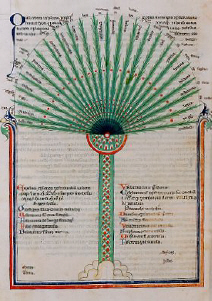“Sign,” as a being or thing, encompasses a great diversity of fields. If, in an Augustinian perspective, every sign is first of all a thing, a thing is not necessarily a sign, even if it can always, to an extent, become one ( De doctrina Christiana, 1.2.2 ); thus, for example, for Christians the events recorded in the Old Testament, res gestae, are “signs” of the New Testament ( De doctrina Christiana, 3.22–23 ). Sign thus partakes of an elaborate setup, which inscribes it as part of a network with realities that, in a way, proceed from it. Signification, variously interpreted. Grounded or motivated in the course of history. The delimiting of the respective fields of “sign” and “symbol” is one of the most problematic of the networks deployed in various languages, from the inaugural distinction of semeion [σημεῖον] and symbolon [σύμβολον] in Greek to the German formation Sinnbild ( literally, meaning [Sinn]-image[Bild], in which Sinn betrays in addition a sensory dimension ), used, for example, by E. Cassirer to designate the “symbol” as what ensures the transition from image to meaning. Such diverse networks, however, can be identified only by detecting certain mutations from the Latin, and even neo-Latin, signum, which allows the “sign” to communicate with the “term,” in accordance, for example, with the “categoreme” vs. “syncategoreme” axis, and have the word signum designate—at a certain stage of the development of medieval logic—what are today called “quantifiers.” From the medieval “sign [of quality]” to the modern “quantifiable symbol,” there are transitions, but they count less than delineating the sets that they link. In what follows, we will present the essential, starting with the Aristotelian send-off, joining up, by way of the Stoic moment and the distortion it induced, with the major oppositions constructed in the Middle Ages around several polarities, whether regarding sources—Aristotle vs. Augustine—or the conceptual structures they convey or propose to recast in their entirety, such as the distinction between natural signs and conventional signs, and, more discretely, and affecting the “sign” itself, that between “sign of” and “sign for,” in which the intersubjective dimension of the sign is explicitly thematized.
